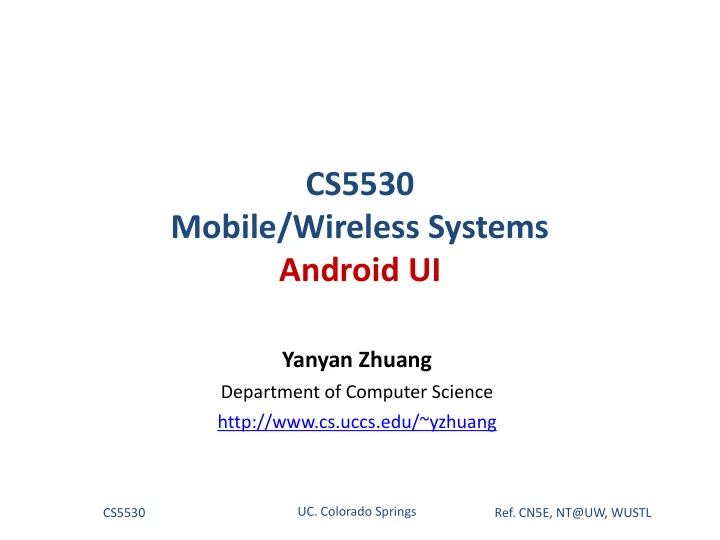

CS5530 Mobile/Wireless Systems Android UI Yanyan Zhuang Department of Computer Science http://www.cs.uccs.edu/~yzhuang UC. Colorado Springs CS5530 Ref. CN5E, NT@UW, WUSTL
cat announce.txt_ • Assignment 2 will be posted soon o Due after midterm • I will be away next Monday o Dr. Chow’s guest lecture • Midterm date o March 20 CS5530 2 Ref. CN5E, NT@UW, WUSTL
Android… • Android o A mobile operating system developed by Google o Based on Linux kernel and designed primarily for smartphones and tablets • IDE o Android studio https://developer.android.com/studio/index.html • Android API o Java as the programming language CS5530 3 Ref. CN5E, NT@UW, WUSTL
Android… • A fast evolving OS: Dashboards } https://developer.android.com/about/dashboards/index.html CS5530 4 Ref. CN5E, NT@UW, WUSTL
Android… • Specify Minimum and Target API Levels o AndroidManifest.xml <manifest xmlns:android="http://schemas.android.com/apk/res/android" ... > <uses-sdk android:minSdkVersion="4" android:targetSdkVersion="15" /> ... </manifest> • Check System Version at Runtime if (Build.VERSION.SDK_INT >= Build.VERSION_CODES.HONEYCOMB) { …... } CS5530 5 Ref. CN5E, NT@UW, WUSTL
Running Android Code • Run code on simulator • Run code on a real device o No license needed o On Android 4.2 and newer, Developer options is hidden by default o Need to enable developer option and USB debugging (Galaxy example): this is all you need to do } Go to Settings > More > About Device, scroll down to Build Number } Tap it repeatedly (7 times) } See the Developer options menu under Settings > check USB debugging CS5530 6 Ref. CN5E, NT@UW, WUSTL
Android Debug Bridge (ADB) • Android Debug Bridge (adb) o Command-line tool to you communicate with a device o Installing/debugging apps, and a Unix shell • A client-server program with three components o A client runs on development machine } Invoke a client by issuing `adb` o A daemon (adbd) runs commands on a device } Runs as a background process on device o A server manages communication between client and daemon } Runs as a background process on development machine CS5530 7 Ref. CN5E, NT@UW, WUSTL
Android Debug Bridge (ADB) • To install adb (Mac OS example) o Install homebrew } ruby -e "$(curl -fsSL https://raw.githubusercontent.com/Homebrew/install/master/install)" o Install adb } brew install android-platform-tools o Start adb } $ adb devices List of devices attached 07f105740c8cad3f device } $ adb shell CS5530 8 Ref. CN5E, NT@UW, WUSTL
Android App Structure • Project files o By default, Android Studio displays files in Android view o manifests } AndroidManifest.xml file o java } Java source code, separated by package names o res } All non-code resources ¨ XML layouts, UI strings, images CS5530 9 Ref. CN5E, NT@UW, WUSTL
Android App Structure • Project files o Project view } Actual file structure of the project ¨ Including all files hidden from Android view o Looks fairly complex now CS5530 10 Ref. CN5E, NT@UW, WUSTL
Create an Android Project • Start a new Android Studio project, or File à New Project o Application Name: "MyFirstApp" o Company Domain: "example.com" • Target Android Devices: keep the default values o We will get back to this later • Add an Activity to Mobile: select Empty Activity • Customize the Activity: keep default values à Finish o Takes a long time to Finish… CS5530 11 Ref. CN5E, NT@UW, WUSTL
Create an Android Project • In Android view o app > java > com.example.myfirstapp > MainActivity.java } Main activity (entry point for your app) } When build and run an app, system launches an instance of this Activity and loads its layout o app > res > layout > activity_main.xml } Defines the layout for the activity's UI o app > manifests > AndroidManifest.xml } Describes the characteristics of the app and defines each of its components o Gradle Scripts > build.gradle } 2 files with this name: one for the project and one for the "app" module } Mostly work with module's build.gradle file to configure how the Gradle tools compile and build your app CS5530 12 Ref. CN5E, NT@UW, WUSTL
Running the App • On a real device o Windows may need USB driver for the device } https://developer.android.com/studio/run/oem-usb.html o Enable USB debugging (earlier) • On a simulator o Create an Android Virtual Device (AVD) definition } Tools > Android > AVD Manager } Create Virtual Device > Select Hardware } System Image > Download (one of the recommended system images) ¨ Takes a long time again CS5530 13 Ref. CN5E, NT@UW, WUSTL
Building Simple User Interface • UI is built w/ a hierarchy of layouts (ViewGroup objects) & widgets (View objects) o Layouts are invisible containers that control how its child views are positioned o Widgets are UI components like buttons and text boxes CS5530 14 Ref. CN5E, NT@UW, WUSTL
Building Simple User Interface • Building UI o XML o Layout Editor CS5530 15 Ref. CN5E, NT@UW, WUSTL
Building Simple User Interface • Component Tree window o Shows the layout's hierarchy of views • ConstraintLayout o A layout that defines the position for each view based on constraints to sibling views and the parent layout CS5530 16 Ref. CN5E, NT@UW, WUSTL
Building Simple User Interface • Change UI strings o res > values > strings.xml CS5530 17 Ref. CN5E, NT@UW, WUSTL
Start Activity • Add a method in MainActivity.java that's called by the button o Intent } An object that provides runtime binding between separate components, such as two activities } The Intent represents an app’s "intent to do something" o putExtra() } An Intent can carry data types as key-value pairs called extras o startActivity() CS5530 18 Ref. CN5E, NT@UW, WUSTL
Add up Navigation • Navigation return to the logical parent screen in app hierarchy o Declare which activity is the logical parent in AndroidManifest.xml <activity android:name=".DisplayMessageActivity" android:parentActivityName=".MainActivity" > <!-- The meta-data tag is required if you support API level 15 and lower --> <meta-data android:name="android.support.PARENT_ACTIVITY" android:value=".MainActivity" /> </activity> CS5530 19 Ref. CN5E, NT@UW, WUSTL
Recommend
More recommend